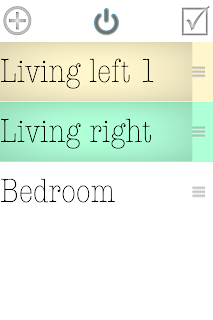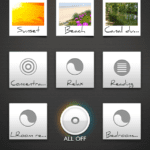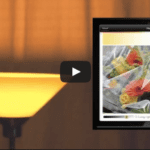Since I first wrote about Philips Hue Apps in January, there have been several new apps released in the iTunes App Store. In general, they have neither ratings nor comments as yet.
A search for “Philips Hue” lists the following, which I’ve classified according to type:
- Biofeedback –pulses the bulbs in sync with your heart rate
- Controller – the app’s main function is to control Philips Hue lights
- Disco – the app’s main function is to provide colour cycling effects
- Fader – turns lights on or off slowly
- Feature – Philips Hue is supported to enhance other functionality
- Market – changes bulb colour to match financial market information
- Mood – changes colour to set mood
- TV Backlight – with one or more bulbs behind your TV, the app matches the image seen by the phone/ipad camera
Detailed reviews after the chart
NR= not reviewed
|
Name |
Type |
Cost |
Rating |
Last update |
iPhone/iPad |
|
AmbiHue |
TV Backlight |
$4.99 |
NR |
April 17, 2013 |
Both |
|
Exoplanet |
Feature |
Free |
— |
April 19, 2013 |
Both |
|
Hue bilight |
TV Backlight |
$.99 |
NR |
January 18, 2013 |
iPhone |
|
Hue Color* |
BioFeedback |
$1.99 |
March 31, 2013 |
iPhone |
|
|
Hue Disco |
Disco |
$2.99 |
** |
March 20, 2013 |
Both |
|
Hue Go |
Disco |
Free |
* |
January 18, 2013 |
iPhone |
|
Hue Market |
Market |
Free |
fail |
April 18, 2013 |
iPhone |
|
Hue+ |
Controller |
$.99 |
** |
April 23, 2013 |
iPhone |
|
Huedini fire |
Mood |
$2.99 |
NR |
April 19, 2013 |
Both |
|
Huedini pulse |
Mood |
$2.99 |
NR |
April 19, 2013 |
Both |
| MagicHue |
Controller/Disco |
$.99 |
*** |
January 29, 2013 |
Both |
|
Magma Hue |
Controller |
Free |
* |
April 3, 2013 |
iPhone |
|
Moods |
although included in “Philips Hue” search results, this app has no functionality related to Hue bulbs |
||||
|
Philips Hue (from Philips) |
Controller |
Free |
*** Essential |
Dec 20, 2012 |
Both |
|
Quick Hue |
Controller |
$.99 |
** |
March 18, 2013 |
iPhone |
|
Ranatree |
Feature |
$1.99 |
NR |
April 7, 2013 |
Both |
|
Rapid Hue |
Controller |
$1.99 |
** |
April 2, 2013 |
iPhone |
|
sunhue |
Fader |
$.99 |
.5* |
April 14, 2013 |
iPhone |
* this app has disappeared since I spotted it.
First, although the Philips Hue app hasn’t been updated, there was a firmware update recently. Unfortunately, the app’s timers are still flakey. They sometimes don’t work, the fade function doesn’t work at all and worst of all, they can’t be set to recur.
I’m surprised that this most basic function – setting a recurring timer to turn lights on or off has not been addressed in any app. There are many ways I’d like to see this function implemented, including the ability to set my latitude/longitude and time zone so that the timer accurately syncs with sunrise/sunset times, but I’d love to have basic recurring timers functionality available.
Secondly, for most of the last four months, I’ve really used the bulbs mostly in their most basic mode – using the switch on the lamp to turn them on and off. The apps are interesting for demos, and sometimes to find the right “golden glow” setting for some quiet music listening, but I’ve not really found much value in any of the apps.
Exoplanet indicates that support for Philips Hue bulbs has been added as an experimental feature. According to the description: “changes the color of the bulbs according to the temperature of the currently selected star”. Maybe I’m looking at the wrong planet/star combinations, or the changes are subtle at best.
Hue Disco has an updated, cleaner interface since my previous review. There’s a new “mood” tab, which slowly cycles colours according to a set of parameters you select. The available moods are sunrise, Christmas, blue and custom. The custom setting allows you to set the colours at either end of the cycle. Cycle time can be set from 5 seconds to 15 minutes. Although it has no practical utility, it may provide some entertainment for the intoxicated. Hue Go has not been updated since my previous review. This is a goofy bit of nonsense. Hue Market promises to change bulb colors based on the current price of selected stocks. You can associate each bulb with a specific stock symbol or market index. You can turn each bulb “on” and “off” – which displays the current market status – green is up, red is down. You cannot change the intensity or brightness and although the description indicates you can set the sensitivity, I couldn’t find that feature nor is it illustrated in the screen shots. Bulb one responded properly. Bulbs two and three did not. For the moment, I’m rating this one as “fail”.
Hue+
The most interesting part of this app is the CIE colour gamut image, which shows very clearly which colours the bulbs can and can’t display. I also like the main screen, which shows you the status and colour of each bulb. Tapping the circle turns the bulb on and off. You can group bulbs together, but you each bulb remains individually controlled. Even on the group display screen, each has to be moved to the colour setting and dimmer level you want, so the point of grouping is to see several on the same screen, rather than to adjust multiple bulbs to the same setting a the same time. At that point, you might as well put all your bulbs in a single group. You can’t save settings, and you can’t set timers.
Magic Hue has not been updated since my last review. This app is a good controller with some nice pulsing colour modes. The app remains a great choice to demo your Philips Hue installation. If you are going to purchase an app, choose this one first.
Magma Hue is a very basic controller with 20 colour squares on the screen, and a dimmer/slider at the bottom. All bulbs are controlled and changed at the same time. The squares do not accurately represent the colour displayed – for example, all of the shades of green are actually variations of orange/yellow. Tapping a square a second time turns the bulbs off.
Rapid Hue is a very basic controller. Each bulb has an on/off switch and four rows of buttons divided into three sections. The left section of four columns controls brightness. The right section of four columns controls intensity. The middle section (which varies in size from portrait to landscape mode from six to thirteen columns) selects the colour. Although this is lacking in granularity and requires a sharp finger, it requires a minimum of fussing to select and change a blub. When turned on, the bulb returns to the previous setting. No grouping, no timers.
Quick Hue is a very basic controller. There’s a master on/off switch and bulbs return to their previous settings when turned on. The main screen shows the colour and on/off status, but not intensity, of each bulb. Bulbs can be grouped into two sections for quick on/off functionality, but colour and dimmer settings remain individually controlled. Selecting colour is slightly cumbersome. You move the circle to the colour you want and then tap – I think there are two slightly different sizes of circle to indicate whether or not you’ve tapped and the colour is now selected. Otherwise, this is confusing – the colour under the circle is not always the colour on the bulb.
sunhue slowly fades the selected bulbs up or down over 30 seconds. You cannot select the start or end colour, you cannot set the duration of the fade time. You cannot preset a time for the fade up or down to start. You must be patient while it finds your Hue bridge.
Please let me know what you think.
Updates:
April 27: Review of Hue+ corrected (and rating updated to 2 stars) after author indicated how to access on/off functionality.









